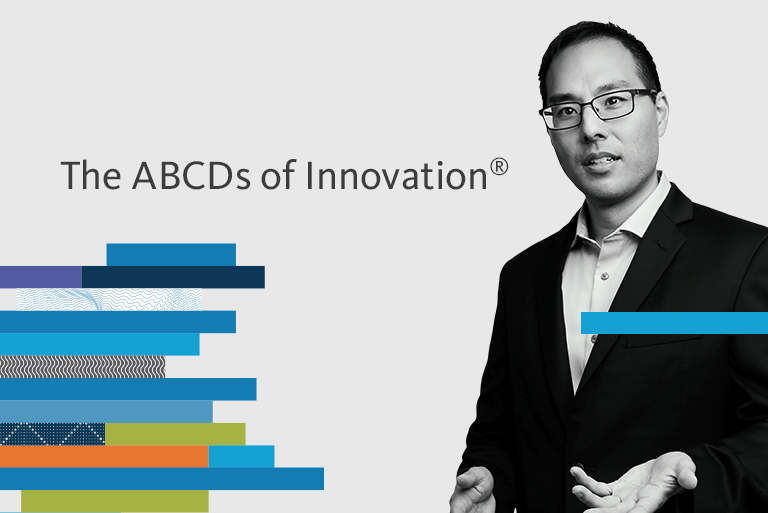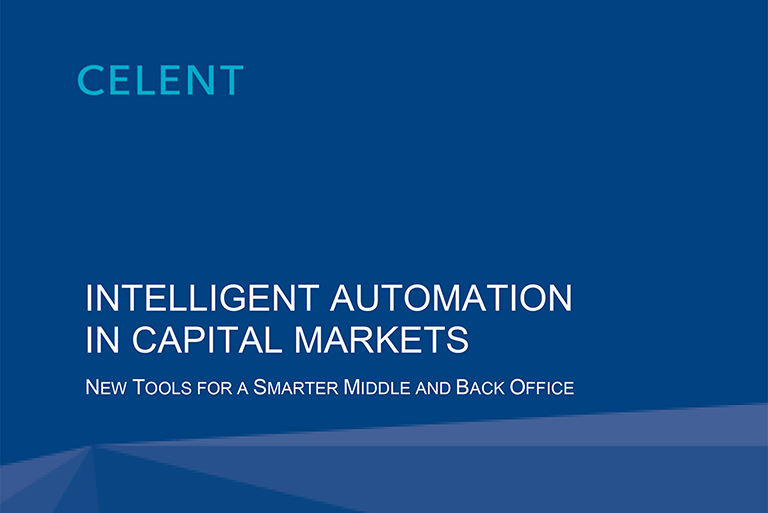AI Adoption: Is Your Firm Ready?
Assess your firm’s readiness for artificial intelligence and find out how to move to the next stage of adoption.

Artificial Intelligence (AI)1 has the potential to radically transform the capital markets industry, resulting in service improvement, faster front-to-back trade life cycle processing, reduced risk and significant cost efficiencies.
Results from Broadridge’s recent survey of over 200 representatives from banks, asset managers, broker-dealers, consultants and regulators showed:
- 80 percent are doing something with AI, but only 22 percent have AI initiatives in production.
- Data quality/standardization and business justification are seen as the top challenges to AI deployment.
- More than 95 percent see value in co-developing AI with other firms and partners.
As with any technological innovation, there are varying levels of adoption. Some firms are leading the pack and investing significant resources in AI, while others have not yet fully embraced the technology.
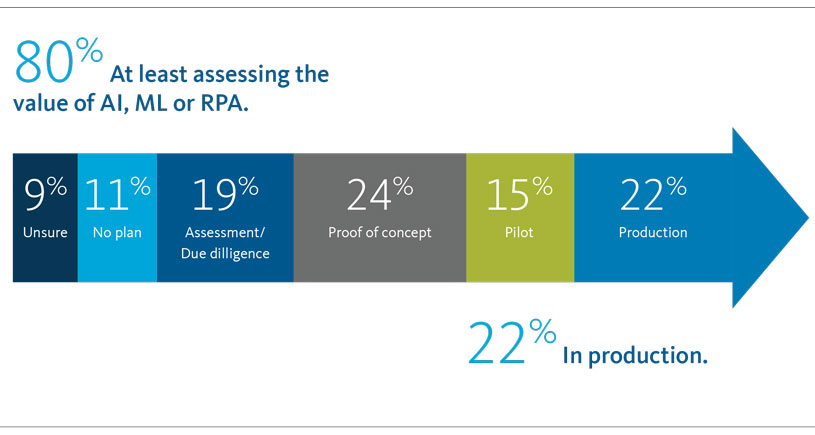
THE FOUR STAGES OF AI ADOPTION
In past waves of technological transformation, a fast follower approach has often paid dividends. It allows others to bear the high cost and risks of investment. Fast followers can then identify where innovators have made errors in process and product design, allowing them to build a better solution.
With AI, things may be different. AI algorithms are often self-teaching and improve over time. They are relatively opaque and hard for competitors to copy or reverse engineer. Innovators may gain a lead that is compounded through advantages in timing and tacit knowledge that cannot be replicated by followers.
Culture and mindset are also hard to change and take time to evolve, both internally (among employees and business leaders) and externally (among regulators, clients and other stakeholders). It is therefore important to start strategizing the use of disruptive technologies early.
Furthermore, robust AI solutions can result in network benefit effects. As more clients are drawn to institutions and service providers with powerful AI capabilities, their algorithms can consume more underlying customer data and in turn become more effective. Hence, we’ve identified four categories (or stages) of AI adoption that better suit the unique nature of this technology than the traditional spectrum of innovators to laggards.
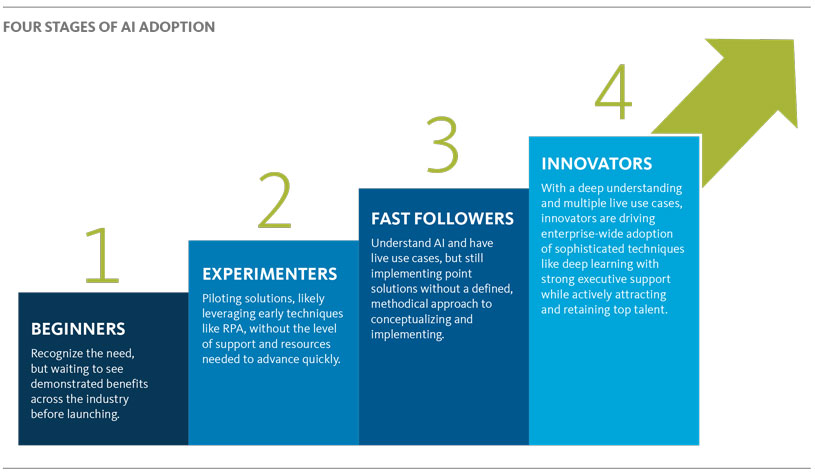
AI READINESS ASSESSMENT
Are you ready to adopt AI as part of your operations?
To gauge your readiness for a successful AI program, we have created an index based upon the following key dimensions:
- Strategy
- Structure
- Systems
- Skills
- Staff
Considering the questions below will enable you to assess your firm’s level of readiness for AI intelligence and provide a framework for moving to the next stage of adoption.
To access Broadridge's online AI readiness assessment tool please visit the following link
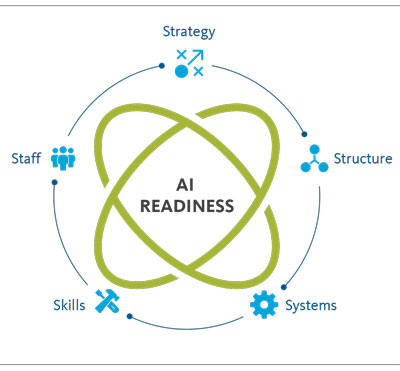
STRATEGY
- Do you have plans to implement AI systematically across the organization rather than point solutions?
Taking an enterprise approach to AI delivers significant economies of scale and benefits like knowledge-sharing to drive innovation. It reduces duplication of effort and encourages more widespread adoption. Looking for synergies in solving internal or client problems across business units enables implementation of AI across the organization rather than just specific business units and functions. A useful first step is to take an audit of all AI initiatives across the firm to see where knowledge can be shared and common problems solved.
- Do senior executives give top-down support to AI adoption across your organization?
To be ready for AI, senior leaders must see AI and data management strategy as a core competence, and data as a valuable asset to the firm. Executive sponsorship is critical to ensuring AI-driven solutions are funded and rolled out effectively while aligning with the firm’s strategic objectives. For example, JP Morgan CEO Jamie Dimon has actively focused on the central role of technology and AI in running a modern bank. Under his stewardship, the firm has become a technological leader in the banking industry, spending $20 billion on new technology products over two years. JP Morgan is now in the process of constructing a new fintech campus in Palo Alto with space for over 1,000 employees.2
- Have you prioritized the problems AI can solve using a defined methodology and a clear business case?
Rather than just throwing technology at a problem, managers should first identify whether it is a problem worth solving and whether AI can address it. That is when the true benefits of AI can be achieved. For example, within the robotic process automation (RPA) space, a framework such as the one shown below can help to prioritize projects.
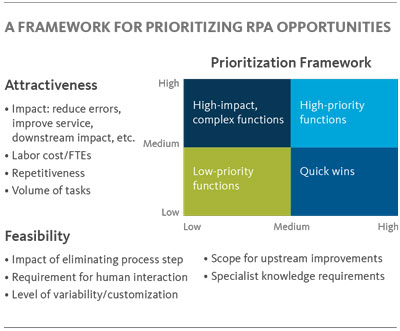
A recent Celent report3 notes that “several processes in the trade life cycle can benefit from the application of intelligent automation.”
These include:
- Trade allocation
- Settlement
- Reconciliation
- Corporate actions dissemination and processing
These functions are seeing the emergence of intelligent automation tools that eliminate a significant amount of manual tasks.
Client life cycle management is another labor-intensive process.
- Many use cases are emerging in “know your client,” onboarding, account and trade supervision, due diligence, investigation and reporting workflows.
- Intelligent, automated tools streamline information extraction and collation for efficient due diligence, while cognitive tools provide new insights for conducting risk assessment and case investigation.
- Do you review external partners and industry experts to look for opportunities to partner or buy in technology?
Data has recently been described as the new oil — the fuel required for AI algorithms to generate meaningful results. Volume, variety and quality of data have become a source of competitive advantage.
Data drives significant network effects, resulting in a virtuous cycle. For example, a strong AI product attracts more users, who generate increasing volumes of data. That data is used to refine and enhance the effectiveness of the AI algorithms. This increasingly powerful product attracts more users and so on, creating high switching costs.4
Institutions without the scale needed to compete are therefore investing in mutualized services built on collective data. Strong partners who leverage large datasets across multiple clients, asset classes and business lines can break down silos and act as ecosystem curators to generate the network effect. By working with a trusted technology leader, firms can transform their operations and mutualize their cost, innovation and investments, creating a cost-effective on-ramp to competitive advantage from next-generation technologies.
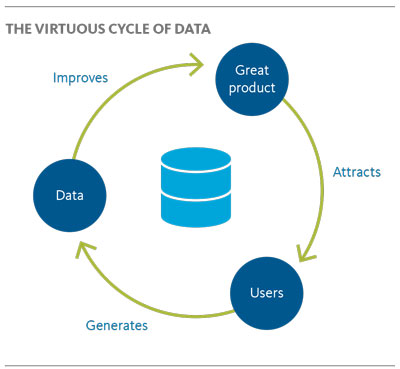
- Have you evaluated the changes to business models resulting from AI?
AI innovators identify ways technology changes existing business models to improve the customer experience rather than just the process. For example, AI can be deployed in a predictive analytics tool for fixed income securities trading, which currently involves direct contact from a dealer to their “favorite” or most high-value clients, typically the top 20 percent. However, the dealer might have dozens or even hundreds of clients outside of that top 20 percent who seldom get attention. Using AI to analyze and predict which clients are most appropriate for a security based on their past trading history and providing that insight to the dealer opens up the entire “long tail” of potential buyers or sellers, which increases the probability of a trading opportunity.
- Have you addressed security and regulatory concerns around AI adoption?
If you’re using AI in trading or risk management, regulators may want you to justify why a decision was made. The “black-box” nature of machine learning, where it is difficult to determine the exact steps taken to reach a certain outcome, raises issues around audit trails. This is leading to a drive toward “explainable AI”5 solutions. Banks are actively working to develop internal frameworks to break through the “explainability barrier” and introduce more transparency into machine learning solutions in the face of growing regulatory scrutiny.
Bias in the decision-making process, sometimes due to factors like visibility, model risk and dynamic feedback loops, is a key issue for AI solutions and could create operational and reputational risk. Firms should also carefully consider any regulations, such as GDPR, that may impact the use of personal data when creating AI programs.
AI could also increase the likelihood and severity of cyber intrusions. Firms need a robust cybersecurity framework to monitor and mitigate threats as they evolve. It is also critical to perform sufficient due diligence to ensure AI providers have mature security procedures in place.
- Do you have clarity on how your AI efforts will translate to on-the-ground impact with specific, measurable but achievable targets for each AI project?
In many cases, AI or RPA may be saving a person’s time. Having a clear plan for reallocating that time will enhance solution value. For example, re-engineering the process or the way teams are organized demonstrates on-the-ground impact and measurable results, which increases the firm’s appetite to invest.
Having a clear process also eliminates aimless project drift and misaligned objectives. Senior management can then outline goals, such as a measurable definition for project success, milestones for tracking and ROI. Demonstrating early wins helps gain critical buy-in as a project progresses.
STRUCTURE
- Have you set up an “AI Center of Excellence?”
Establishing a center of excellence helps incubate concepts, which can then be propagated across the organization to socialize current initiatives. This helps to educate others in the firm, particularly business people who can combine process understanding with a knowledge of how AI works to generate innovative use cases.
It is, however, essential to avoid creating a silo that isolates the people best-placed to identify how AI can provide a solution to internal or client problems. Ensuring those in the center of excellence work in close partnership with the business is therefore fundamental to successful development and rollout of AI across the firm.
“According to the Harvard Business Review, 37 percent of U.S. executives from large firms using AI had centralized oversight groups, including Deutsche Bank, JPMorgan Chase, Pfizer, Procter & Gamble, Anthem and Farmers Insurance.6”
- Do you bring cross-functional groups together to identify AI use cases?
The most effective AI applications will come from a convergence of disparate skillsets. Cross-functional communication between business people, traders, heads of operations, quants, data scientists and experts in programming and governing AI will enable firms to develop novel solutions that outperform those used by other institutions.
Ideally, project teams should feature a diversity of thinking styles and personality types. This includes a mix of visionaries, analytical thinkers who can identify risks and problems, translators, mediators and implementers who can drive a project through to completion.
Domain expertise is also critical when designing AI use cases. Those with knowledge of how the business operates and of the day-to-day problems clients face are best placed to identify and evaluate new applications for AI. It is vital that these business people are also equipped with a basic understanding of how AI works in order to communicate effectively with data scientists and developers. Furthermore, business teams should also have ownership of the effort to ensure buy-in to any solutions that are implemented.
SYSTEMS
- Have you centralized data across silos and do you have an enterprise data management (EDM) strategy?
To train AI, large volumes of high-quality data with a consistent ontology and integrity are required. The firm should also have a clear grasp of data lineage and an understanding of data privacy and regulatory constraints.
Prioritizing which data can be best applied to create AI use cases is a further key consideration. Thinking about the end result when designing centralized data lakes can help. What do you want to achieve? Is a given dataset worth the time and cost involved in solving a big data problem with it?
This works best across the industry when there is a standardized ontology/taxonomy for trading data fields that enable improved interactions across a network of industry participants.
“A robust data fabric must support the modernization of storage and management and move away from the proliferation of silos. But a data fabric must also integrate with legacy systems, without requiring their presence for the longterm. To work effectively, a data fabric must be broad and support a vast array of applications and types at scale across locations.”
For further reading on this topic, see the Broadridge Enterprise Data Management (EDM) Health Check
- Do you have an architecture and process for experimenting with AI solutions?
Critical to the success of any AI implementation is testing, implementing in production, governing, learning from the results and optimizing. Putting the appropriate architecture and processes in place allows firms to:
- Consume the right data to build AI algorithms.
- Run experiments in a sandbox environment where data is not continually changing.
- Assess performance against objectives using clear metrics.
- Deploy into production.
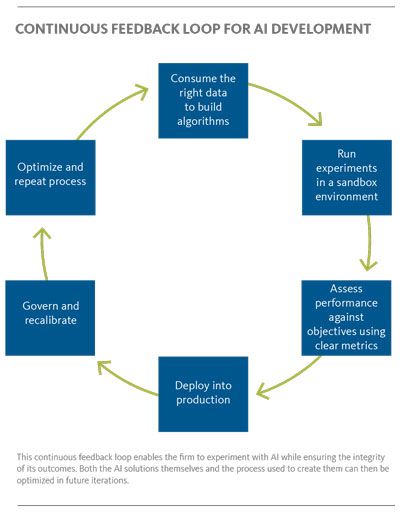
- Continuously govern and recalibrate to identify issues arising from bad data or poorly designed algorithms, as well as the impact of new data entering the system.
- Optimize based upon lessons learned to create a repeatable process and allow for further experimentation.
SKILLS
- Are you investing in people to write programs with sufficient skill, intelligence, imagination and understanding?
A recent McKinsey study suggested firms should benchmark the number of staff with data, analytics and AI expertise per 1,000 full-time equivalents (FTEs). McKinsey noted: “In purely numeric terms, they [outperformers] are 2.5 times more likely than other companies to employ more than 25 analytics professionals per 1,000 FTEs.”
In addition to headcount, this also requires hiring people with the ability to think laterally and break existing assumptions, patterns and ways of doing things before starting to apply AI.
By reimagining processes first and then using technology to facilitate new ways of delivering value, a more effective and innovative end solution can be designed. This includes asking questions, such as:
- Where is technology making existing business models obsolete?
- How can innovations in other industries be applied against financial services use cases?
STAFF
- Have you defined a change management program for AI, taking into account people, political and workforce factors?
Managing the disruptive change that AI will bring, while maintaining a human-centric approach, will be critical to the deployment of AI solutions at scale. Successful change management considerations include:
- Re-imagining job design. How can AI be used to augment and enrich human roles and what new skills and training are required for humans to adapt to this change?
- Involving those impacted most in developing use cases. Workforce engagement early in the process, where possible, can significantly increase success in the adoption of new technology.
- Identifying where cultural inertia and pushback could inhibit deployment. There may be a lack of willingness to train AI due to the perception among staff that they will become obsolete.
- People will still be required. Humans with knowledge of the business, clients, processes and operations will still be required to oversee, govern and act on new decision-making tools.
- Communicate the benefits of AI to the workforce. For example, reducing manual tasks to enable them to focus on value-added work and the plan for retraining and new opportunities
- Demonstrate early wins. As projects hit key milestones, track these as wins.
While humans will still be required in many roles due to the difficulty of creating general AI intelligence, AI will also facilitate new ways of working to augment human decision-making.
Careful thought should be given to how this impacts role satisfaction, and how to redesign roles to adapt to the impact of AI.
- Do you have a defined plan to attract, retain and nurture AI talent?
Recruitment policy needs to highlight creative thinking and experimentation, data analysis and interpretation, and strategy development. Along with T-shaped knowledge across functions and an ability to communicate across organizational boundaries, these will be the human skills required to succeed as the basis of competition evolves.
In the future, financial firms may also need to change their cultures to attract the right skillsets. They are now competing with Google, Apple and Amazon for top data scientists. Senior leaders will therefore need to realign away from a more traditional view of the world toward a mindset of digital transformation. This leads to important considerations around culture, working environment and the ability for highly skilled staff to collaborate with other smart people on interesting and meaningful AI-driven projects. Demonstrating to potential recruits that the firm has a mature AI strategy, as outlined in the AI readiness index, will play a significant role in attracting and retaining vital expertise and driving a culture of innovation.
CONCLUSION
While levels of AI investment and readiness among financial market participants vary widely, most organizations recognize the potential for radical change that AI will bring and are investing in solutions.
It is possible to adapt to technological change and to improve the chances of success by first putting in place a clear strategy and the basic building blocks that facilitate successful AI adoption.
Working with trusted and experienced partners, such as Broadridge, can offer network value and also provide access to the scale of data and the expertise required to implement AI. This allows market participants to mutualize costs and gain competitive advantage well into the future as the next wave of AI drives disruptive change in business and operating models.
Considering the key dimensions of strategy, structure, systems, skills and staff will help you to think about some of the key considerations needed to optimize and scale your firm-wide AI program in an era of demanding technological change.
- In this paper, “artificial intelligence” is used in its broadest sense based on the Oxford English dictionary definition: “...computer systems able to perform tasks normally requiring human intelligence, such as visual perception, speech recognition, decision-making and translation between languages.” This catch-all term covers techniques such as machine learning, robotic process automation, deep learning, natural language processing and more.
- CNBC: Jp Morgan’s Jamie Dimon Makes His Biggest Bet On Silicon Valley With New ‘Fintech Campus’
- Arin Ray, Celent: Intelligent Automation In Capital Markets. 2019
- World Economic Forum Paper: The New Physics of Financial Services
- Risk Magazine: Machine Learning Hits Explainability Barrier
- Harvard Business Review: How to Set Up an AI Center of Excellence

